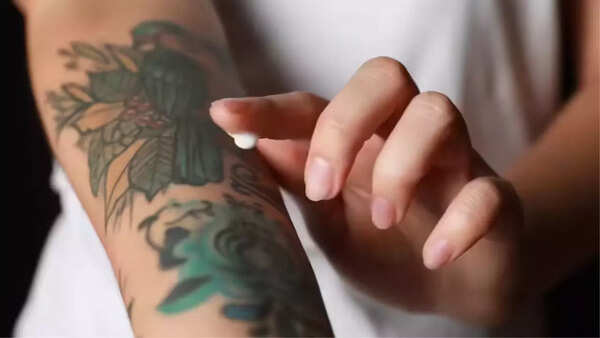Thinking of getting a tattoo? Know where it hurts most, what to ask your artist, and tattoo aftercare tips
Getting a tattoo is a significant decision that demands thorough consideration. From the initial design and placement to selecting the right artist, every step is crucial for a satisfying experience. While some tattoos hold deep personal meaning, it's most important that you are happy with the final result. The key to a positive experience lies in proper preparation and diligent aftercare, allowing you to fully enjoy and appreciate the art permanently etched onto your skin.
Thinking about getting your first tattoo? Whether you've meticulously planned your ink or are just beginning to explore the idea, this guide provides essential information to navigate the process.
Tattoo Prep Guide: Style, Font, Colors for Your Skin Tone, and Best Placement Tips

1. Style
Once you've decided what you want, determine how you want it to look. The possibilities are vast, including:
- American Traditional
- Traditional Japanese
- Realism
- Illustrative
- Neo-Traditional
- Minimalism or Geometric
2. Choosing the Right Font
If your tattoo includes words or text, font selection is paramount. Test various fonts to visualize their appearance on your body. Print several versions of your chosen font to provide your artist with a precise reference, ensuring accurate replication.
3. Tattoo Colors and Skin Tone
Consider how tattoo colors will appear on your skin tone over time. Lighter skin tones often showcase white ink, reds, and purples effectively. Deeper skin tones tend to hold darker colors like crimson red and royal blue better.
4. Tattoo Size and Placement Considerations
Carefully consider the size and location of your tattoo, as these factors affect how the design ages. Think about the desired visibility and choose a location that complements the design. Consult your artist to determine the ideal size and placement, ensuring satisfaction with the final outcome.
What to Check Before Letting a Tattoo Artist Ink You

1. Verify Licensing:
Confirm that both the tattoo shop and the artist possess valid licenses. Check your local regulations to ensure proper certification.
2. Prioritize Hygiene:
A reputable shop prioritizes health and safety. Look for a clean and well-maintained environment. Ensure the artist uses single-use needles, ink, gloves, and other equipment to prevent cross-contamination.
3. Assessing Shop Courtesy and Artist Compatibility:
Consider the artist's professionalism and personality. It’s important to feel comfortable and confident in their abilities. If you feel uneasy, explore other options. A consultation can help you gauge the artist's enthusiasm and seriousness towards their work.
Questions to Ask Your Tattoo Artist
Asking the right questions upfront will help ensure a successful experience. Consider asking the following:
- Experience and Qualifications: How long have you been tattooing, and what's your specialty?
- Portfolio: Can I see your past work to gauge your style and range?
- Guarantee and Touch-Ups: Do you offer free touch-ups for any issues during healing?
- Pricing: What's your hourly rate or pricing structure?
- Sanitation and Safety: How do you sanitize equipment, and do you use latex-free gloves?
- Ink and Materials: What brand of ink do you use, and can you accommodate any allergies?
- Design Placement: Where would you recommend placing the design for the best results?
- Aftercare: What aftercare routine do you recommend for proper healing?
These questions ensure you're working with a qualified artist who can deliver the results you want while prioritizing your safety and satisfaction.
How Much Does a Tattoo Hurt? It Depends
Getting a tattoo involves pain. The intensity varies based on the tattoo's size, location, and your individual pain tolerance. Sensitive areas with nerves and less flesh, such as the forehead, neck, spine, ribs, hands, fingers, ankle, and top of the feet, tend to be the most painful. Areas like the bicep or thigh are generally less sensitive.
Tattoo Aftercare Tips You Can Follow
Proper tattoo aftercare is crucial for optimal healing and preserving the vibrancy of your ink. Follow these steps:
- Keep the dressing on for a few hours, then wash your hands before removing it.
- Clean the tattoo with a gentle, unscented soap or your artist's recommended cleanser.

- Pat dry with a clean towel; avoid rubbing to prevent ink loss.
- Apply ointment or lotion if skin feels dry or itchy, using fragrance-free products.
- Follow your artist's aftercare instructions and avoid picking at flaking skin to prevent damage.
Newer articles
Older articles
-
 Suchitra Krishnamoorthi faces backlash for claiming Air India crash survivor was ‘LYING’; Deletes post and issues apology
Suchitra Krishnamoorthi faces backlash for claiming Air India crash survivor was ‘LYING’; Deletes post and issues apology
-
 Mahbub Anam replaces Faruque Ahmed as new BPL chairman
Mahbub Anam replaces Faruque Ahmed as new BPL chairman
-
 This new AI tool can help you book train tickets, get refunds and check details on IRCTC website and app
This new AI tool can help you book train tickets, get refunds and check details on IRCTC website and app
-
 'Would be remarkable to choose someone else if their last knock was a 170'
'Would be remarkable to choose someone else if their last knock was a 170'
-
 Selena Gomez and Hailey Bieber UNFOLLOW each other amid Justin Bieber drama
Selena Gomez and Hailey Bieber UNFOLLOW each other amid Justin Bieber drama
-
 Will Nysa Devgan enter Bollywood like Raveena Tandon's daughter Rasha Thadani? Kajol reveals the truth
Will Nysa Devgan enter Bollywood like Raveena Tandon's daughter Rasha Thadani? Kajol reveals the truth
-
 Teen Innovator Soars to New Heights: Mehar Singh Breaks Guinness World Record with Lightning-Fast Drone Ascent
Teen Innovator Soars to New Heights: Mehar Singh Breaks Guinness World Record with Lightning-Fast Drone Ascent
-
 How do graphic designers convert JPG to PDF (Portable Document Format)?
How do graphic designers convert JPG to PDF (Portable Document Format)?
-
 Still swooning over Ahn Hyo Seop and Kim Sejeong in ‘Business Proposal’? Here are 3 new K-Dramas to obsess over next!
Still swooning over Ahn Hyo Seop and Kim Sejeong in ‘Business Proposal’? Here are 3 new K-Dramas to obsess over next!
-
 iQoo Z9 Turbo new leak reveals key specifications: All the details
iQoo Z9 Turbo new leak reveals key specifications: All the details